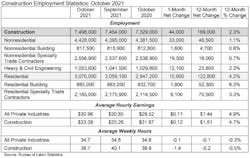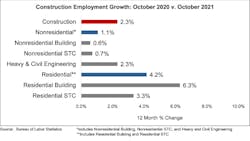PRESS RELEASES
WASHINGTON, Nov. 5, 2021 —The construction industry added 44,000 jobs between September and October as nonresidential construction firms posted back-to-back increases for the first time since January, according to analyses by the Associated General Contractors of America (AGC) and Associated Builders and Contractors (ABC) of new data from the U.S. Bureau of Labor Statistics (BLS).
Overall, the industry has recovered 963,000, or 86.5%, of the jobs lost during earlier stages of the pandemic. The construction unemployment rate decreased to 4.0% in October. Unemployment across all industries fell from 4.8% in September to 4.6% last month..
Construction employment in October totaled 7,498,000, an increase of 44,000 since September. However, industry employment remained 150,000 below the pre-pandemic peak set in February 2020.
The nonresidential segment, comprising nonresidential building and specialty trade contractors, plus heavy and civil engineering construction firms, added 33,000 employees in October, following a pickup of 25,800 in September. But nonresidential employment is still 239,000 below the February 2020 level, as the sector has recovered only 63% of the jobs lost in the first two months of the pandemic.
Residential construction--including building contractors such as homebuilders, along with residential specialty trades--added 10,900 employees in October. Residential employment tops the February 2020 mark by 89,000.
“It is encouraging to see continuing job growth in nonresidential construction but the industry remains far behind the overall economy in recovering all of the job losses from the pandemic,” said Ken Simonson, AGC’s chief economist. “Finding workers is a challenge after other sectors have been hiring for much longer.”
“After two months of disappointment, the U.S. employment market bounced back,” added ABC Chief Economist Anirban Basu. “Many economists believed that seasonal adjustments artificially suppressed statistical employment growth in September. That appears to have been correct. Nonetheless, employers continue to report difficulty filling available positions and job growth has slowed significantly since the initial periods of the economic recovery. The expectation is that labor force participation will continue to pick up going forward, albeit gradually."
Over time, economic activity will trend toward normalcy: steadily dissipating inflation, fewer input shortages, slower wage growth and more typical construction delivery costs, Basu explained. Unleashing that dynamic will be critical to keeping the current recovery going. Notably, contractors expect sales to increase over the next six months, according to ABC’s Construction Confidence Index.
“With workers remaining scarce, businesses have stepped up equipment purchases to boost productivity,” noted Basu. “Indeed, the most recent bout of labor shortages will prompt many contractors to increase their purchases of emerging technology and equipment. While those purchases, along with associated training costs, may limit cash flow in the short term, ultimately it will translate into faster productivity growth and expanded enterprise profitability in the more distant future.”
##########











